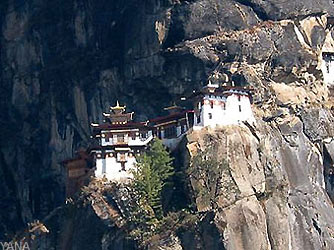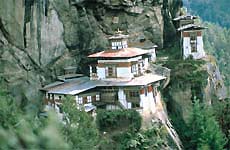 In
the 12th century,
Mahasiddha Pha Dampa Sangye, the famous
Indian saint who introduced the Chod system in Tibet, visited Taktshang.
His disciple, the famous yogini Machig Labdron, is said to have left a
foot-print on a rock at Taktshang known today as Machigphug. In
the 12th century,
Mahasiddha Pha Dampa Sangye, the famous
Indian saint who introduced the Chod system in Tibet, visited Taktshang.
His disciple, the famous yogini Machig Labdron, is said to have left a
foot-print on a rock at Taktshang known today as Machigphug.
Around
the same time, Duesum Khenpa Karmapa Choekyi Dragpa (1110-1193),
who founded the Karma Kagyu in Tibet, also made a pilgrimage to Taktshang.
 In
the13th century, Phajo
Drugom Zhigpo (1154-1252), the founder of the Drukpa Kagyu School in Bhutan, Gyalwa Lhanangpa
(1164-1224),
the founder of Lhapa Kagyu, and the famous monk, Rinchen Moenlam,
also meditated at Taktshang. In
the13th century, Phajo
Drugom Zhigpo (1154-1252), the founder of the Drukpa Kagyu School in Bhutan, Gyalwa Lhanangpa
(1164-1224),
the founder of Lhapa Kagyu, and the famous monk, Rinchen Moenlam,
also meditated at Taktshang.
 In
the 14th century,
Taktshang was visited by the Indian Buddhist Saint, Nagi Rinchen and, in the 15th century, Drubthob
Thangthong Gyalpo (1385-1464) is
said to have discovered important hidden manuscripts during his meditation
at Taktshang. In
the 14th century,
Taktshang was visited by the Indian Buddhist Saint, Nagi Rinchen and, in the 15th century, Drubthob
Thangthong Gyalpo (1385-1464) is
said to have discovered important hidden manuscripts during his meditation
at Taktshang.
 In
the 16th century, Terton
Pema Lingpa discovered the religious texts of "Kuenzang Yathig"
and "Kagyed Yangsang Lamed" after intense meditation in Taktshang.
Other saints like Machig Labdron and Terton Lethro Lingpa also meditated
in the Taktshang cave. Religious pilgrims to Taktshang throughout
Bhutanese history include successive Je Khenpos including the late Geshe
Geduen Rinchhen who was born in a cave near Taktshang. In
the 16th century, Terton
Pema Lingpa discovered the religious texts of "Kuenzang Yathig"
and "Kagyed Yangsang Lamed" after intense meditation in Taktshang.
Other saints like Machig Labdron and Terton Lethro Lingpa also meditated
in the Taktshang cave. Religious pilgrims to Taktshang throughout
Bhutanese history include successive Je Khenpos including the late Geshe
Geduen Rinchhen who was born in a cave near Taktshang.
 Taktshang
saw significant development as a monastic site in the 17th
century when Zhabdrung Ngawang Namgyel took over its custody. The plan to build a lhakhang at Taktshang was originally
that of Zhabdrung himself. It was at Taktshang, during the Tibetan war
of 1644/46,
that he and his Tibetan Nyingmapa teacher, Terton Rigdzin Nyingpo,
first performed the ritual associated with the Tshechu, invoking Padma
Sambhava and the protective deities to achieve victory over the invading
armies. Taktshang
saw significant development as a monastic site in the 17th
century when Zhabdrung Ngawang Namgyel took over its custody. The plan to build a lhakhang at Taktshang was originally
that of Zhabdrung himself. It was at Taktshang, during the Tibetan war
of 1644/46,
that he and his Tibetan Nyingmapa teacher, Terton Rigdzin Nyingpo,
first performed the ritual associated with the Tshechu, invoking Padma
Sambhava and the protective deities to achieve victory over the invading
armies.
In a meditative vision at that moment, the local deity of Taktshang
came to the Zhabdrung in the form of a black man and offered Taktshang
to him, saying that if he took it, he would ensure that no one could ever
steal it. As it turned out, Bhutan's success in the war became a defining
moment in the country's history, but the Zhabdrung was never able
to carry out his plan to build the celebratory lhakhang.
Gyalse
Tenzin Rabgye, the fourth Druk Desi, remembered participating in those
events as a young monk in the Zhabdrung's entourage and building
a lhakhang was a fulfillment of the Zhabdrung's wish. It was during the
course of one such tour of the Paro valley, in 1692,
that Gyalse Tenzin Rabgye traveled to
the Taktshang Pelphug. There, upon the cliff, he organised the celebration
of the Tshechu, and commanded that the foundation be laid for a
lhakhang dedicated to Guru Rinpoche, to be called the "Temple
of the Guru with Eight Names" (Guru Tshen Gyed Lhakhang).
The
work on the lhakhang began by the 10th month of the Water Monkey Year and
the two-storied lhakhang was completed by 1694.
He had assigned his chief artisan, Dragpa Gyamtsho, to supervise
the construction of the lhakhang. The construction of the Taktshang Monastery
and its history was accompanied by many auspicious signs and miracles.
Gyalse
Tenzin Rabgye once again traveled to Taktshang in 1694 to perform the consecration ceremony on the completion of the lhakhang.
At that time, the tradition of the annual celebrations was established.
The Drubkhang is still opened once a year during the annual ceremony
which is performed by 71 members of the Dratshang (monk body) led
by the Tshennyi Lopon (Master of Dialectical Studies).
 Between 1961
and 1965, the monastery was renovated
by the 34th Je Khenpo, Shedrup Yoezer. The latest additions were
made in 1982.
The Lam Neten of Paro said that the reconstruction of the Taktshang
Monastery, during the reign of His Majesty King Jigme Singye Wangchuck,
was not just an important event in the history of Bhutan but it was an
invaluable contribution to the preservation, teaching, and strengthening
of Buddhism, one of the world's great religions. Between 1961
and 1965, the monastery was renovated
by the 34th Je Khenpo, Shedrup Yoezer. The latest additions were
made in 1982.
The Lam Neten of Paro said that the reconstruction of the Taktshang
Monastery, during the reign of His Majesty King Jigme Singye Wangchuck,
was not just an important event in the history of Bhutan but it was an
invaluable contribution to the preservation, teaching, and strengthening
of Buddhism, one of the world's great religions.
|




